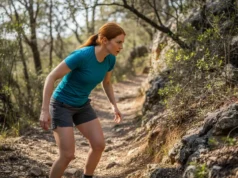In this article
Imagine this: a simple ankle roll on what you thought was an “easy” two-hour hike. Now it’s dusk, the temperature is dropping, and your car is three miles of rugged trail away. This common scenario, often the start of a search-and-rescue call, isn’t about bad luck; it’s about a gap in hiking and backpacking preparedness. The most critical piece of gear isn’t what’s in your backpack, but the system you build before you even leave home. This doctor’s guide will teach you how to move beyond a simple checklist and construct a DIY hiker’s emergency kit—a true lifeline customized for any adventure. By the end, you will have learned to build your own emergency kit, customize it with confidence using a repeatable decision matrix, organize and physically pack the kit for rapid deployment, and integrate skills with gear so that your brain, not your bag, becomes your most powerful tool.
What is the Anatomy of a Wilderness Emergency System?
Why Are the “Ten Essentials” a System, Not a List?
The Ten Essentials—Navigation, Illumination, Sun Protection, First Aid, Repair Kit/Tools, Fire, Emergency Shelter, Extra Food, Extra Water, and Extra Clothes—are the foundational framework for all outdoor recreation and safety, established by The Mountaineers and promoted by the National Park Service (NPS). Over time, this framework has evolved from a literal 1930s list to a modern “systems” approach. Your DIY emergency kit is the practical manifestation of several of these systems combined—specifically First Aid, Fire, Shelter, and Repair—and is the starting point for any backpacking survival kit.
The systems approach encourages thinking about function and capability rather than simply checking off objects; for example, “Illumination” means a Black Diamond Icon headlamp plus spare lithium AAA batteries or a mini headlamp backup. This philosophy combats the “short-trip fallacy”—the dangerous assumption that less gear is needed for shorter hikes—and data confirms most emergency incidents occur on day hikes because of this miscalculation. Getting lost (a Navigation system failure) can lead to an unplanned night out, making the Shelter, Fire, and Extra Food systems critical for survival. Adopting this mindset is the first step from being a recreational hiker to a self-reliant one, as explored further in our complete guide to the Ten Essentials.
What Belongs in the Medical Module for Treating the Body?
This module is framed not as a “boo-boo kit,” but as a system for treating injuries and illnesses guided by wilderness medicine principles. Build on a first aid kit checklist that includes essential first aid supplies: sterile gauze roll, pressure dressings, an 18-gauge irrigation syringe, antiseptic wipes, antibiotic ointment, and assorted adhesive bandages in multiple sizes. For blister prevention, pack moleskin and Leukotape; for treatment, add hydrocolloid pads and a small safety pin for sterile drainage. Core OTC medications are 200 mg ibuprofen, 500 mg acetaminophen, 25 mg antihistamine, and 2 mg loperamide. Personal medications—such as an EpiPen for severe allergy treatment or an asthma inhaler—must be clearly labeled and stored in a waterproof nylon bag.
Musculoskeletal injuries justify a lightweight, foam-covered aluminum SAM splint paired with a 40-inch triangular bandage, plus a 3-inch ACE wrap for compression. Severe bleeding may require a windlass tourniquet and hemostatic gauze, but only with formal wilderness first aid training. Non-negotiable tools include nitrile gloves, trauma shears, precision tweezers, and a CPR microshield mask with a one-way valve. For authoritative baselines, consult recommendations for a basic first-aid kit from the American Red Cross, and for deeper blister coverage see a complete system for preventing hiking blisters.
What Belongs in the Survival Module for Enduring the Environment?
The survival kit addresses exposure, getting lost, and dehydration by integrating the non-medical Ten Essentials into a lightweight package. Fire starting demands redundancy: a mini Bic lighter, UCO stormproof matches, and a firesteel, all paired with waterproof tinder such as petroleum-jelly-soaked cotton balls in resealable bags. Shelter choices range from an ultralight reflective space blanket to a reusable SOL emergency bivy. A 150-lumen Black Diamond Icon headlamp with spare lithium AAA batteries is non-negotiable for hands-free tasks.
Navigation tools rely on a layered system: primary map & compass (a 2-degree Brunton TruArc 7 compass), secondary smartphone with offline maps plus a 10 000 mAh power bank, and tertiary Garmin inReach Mini for SOS. A Leatherman tool (mini) or Swiss Army Knife plus 25 ft of 550 paracord and a duct tape mini roll handle repairs. Backup hydration uses a 1-oz Sawyer Mini filter or chlorine-dioxide tablets, paired with two 200-calorie energy bars. Signaling tools include a 120 dB whistle and signal mirror. For water-treatment options see Choosing the right water filter or purifier.
How Do You Customize Your System for Any Hike?
What is the Decision Matrix for Scaling Your Kit?
A one-size-fits-all kit is a recipe for failure; instead, use a decision matrix that weighs trip duration, remoteness, group size, terrain, and group dynamics. A short day hike on a popular trail has a different risk profile than a solo overnight backpacking trip in remote alpine terrain. This matrix cross-references trip type with gear categories to give trip-specific supplies and kit customization recommendations.
Desert hikes demand oral rehydration salts and extra water-purification tabs, while alpine treks justify adding chemical hand warmers and a 4-season emergency bivy. A solo backpacker needs total self-sufficiency and redundancy, making a satellite messenger almost mandatory; a group leader must carry a larger “group” kit and be aware of specific trail risks and participant medical needs. This deliberate process is the hallmark of an experienced and responsible hiker, validated by An Evidence-Based First Aid Kit.
How Should You Organize and Pack Your Kit for Rapid Deployment?
What is the Modular “Ditty Bag” System?
A disorganized kit is nearly useless in an emergency, so adopt a modular packing system using color-coded stuff sacks or quart-size freezer-grade bags. A red “Trauma” pouch holds a pressure bandage and CPR mask; a blue “Meds & Minor Wounds” pouch stores adhesive bandages, moleskin, and OTC meds; an orange “Survival” pouch secures firestarters, stormproof matches, and a space blanket. All pouches fit into a single 3-liter roll-top waterproof container placed in the backpack’s top lid for instant access.
Pro-Tip: Before every trip, perform a 60-second “drop test”: open your fully packed emergency kit, close your eyes, and locate the tourniquet, headlamp, and lighter by feel. If any item takes longer than five seconds to find, re-organize until muscle memory takes over.
Maintenance is non-negotiable: a laminated checklist—based on the Wilderness Medical Handbook by Paul Nicolazzo—is stored inside the kit, and a biannual reminder ensures prescription medications are in date and used items are restocked. For broader weight distribution and organization, read master the art of packing a backpack.
Why Is Your Brain the Most Important Part of Your Kit?
How Does Training Transform Your Kit from a Bag of Supplies into a Toolbox?
A first aid kit is only as good as the user’s ability to deploy its contents; gear enables skill, it does not replace it. Every serious hiker should complete a 16-hour wilderness first aid course—training designed for remote environments and often delivered by the Wilderness Medicine Training Center. The Patient Assessment System (PAS) prevents panic and ensures critical threats are managed first. What Wilderness First Aid training entails is outlined by Scouting America.
The PAS teaches Scene Size-up, Primary Survey (ABCDEs), and Secondary Survey (head-to-toe exam, vitals, patient history). Mastering it inoculates you against Optimism Bias (“It won’t happen to me”) and Summit Fever (continuing despite warning signs). Preparedness is framed not as pessimism but as the mark of a professional who actively manages risk. When crisis strikes, you can move from paralysis to purposeful action by applying the lessons found in our guide to handling a hiker’s emergency.
| Kit Type | Pros | Cons | Essential Add-ons |
|---|---|---|---|
| DIY Kit | Highly customizable, tailored to specific trip/skills. | Requires knowledge to assemble, may be missing critical items. | All items, based on your training and trip needs. |
| Pre-Packaged Kit | Convenient, all-in-one, good for beginners. | May include unnecessary items, may lack specific essentials. | Prescription medications, blister care, extra dressings, survival tools. |
Conclusion: Your Emergency Kit as a Living System
The most effective emergency kit is a two-part system: a Medical Module for the body and a Survival Module for the environment, rooted in the Ten Essentials. Intelligent kit customization based on trip duration, terrain, and group needs is non-negotiable. A modular packing system placed for immediate access is critical for a kit to be useful under stress. Wilderness first aid training and awareness of cognitive biases are more critical to your safety than any single piece of gear. Start building your system today—use this guide, get the training, and explore the wilderness with the profound confidence that comes only from true preparedness.
Frequently Asked Questions
What should be in a hiker’s first aid kit?
A hiking first aid kit should contain essential first aid supplies: adhesive bandages, gauze roll, antiseptic wipes, medical tape, tweezers, scissors, moleskin, ibuprofen, acetaminophen, antihistamine, and aspirin. Personal medications such as an EpiPen or asthma inhaler must be added based on specific allergies and prescription requirements.
How is a survival kit different from a first aid kit?
A first aid kit treats injuries to the human body, while a survival kit provides tools to endure environmental threats. The survival kit includes the non-medical Ten Essentials: map & compass, firestarters, emergency shelter, water filter, knife/multitool, lightweight food, and extra layer.
What are the 10 essentials for hiking?
The Ten Essentials are a system of interconnected categories crucial for safety: Navigation, Illumination, Sun Protection, First Aid, Repair Kit/Tools, Fire, Emergency Shelter, Extra Food, Extra Water, and Extra Clothes. Thinking of them as “systems” rather than a literal list is the key to proper backpacking preparedness.
What are the most common hiking injuries?
According to studies of national park incidents, the most common injuries are sprains, strains, fractures, and lacerations. This data highlights why your hiking first aid kit checklist needs robust supplies for musculoskeletal support and wound care basics, not just small adhesive bandages.
Risk Disclaimer: Hiking, trekking, backpacking, and all related outdoor activities involve inherent risks which may result in serious injury, illness, or death. The information provided on The Hiking Tribe is for educational and informational purposes only. While we strive for accuracy, information on trails, gear, techniques, and safety is not a substitute for your own best judgment and thorough preparation. Trail conditions, weather, and other environmental factors change rapidly and may differ from what is described on this site. Always check with official sources like park services for the most current alerts and conditions. Never undertake a hike beyond your abilities and always be prepared for the unexpected. By using this website, you agree that you are solely responsible for your own safety. Any reliance you place on our content is strictly at your own risk, and you assume all liability for your actions and decisions in the outdoors. The Hiking Tribe and its authors will not be held liable for any injury, damage, or loss sustained in connection with the use of the information herein.
Affiliate Disclosure: We are a participant in the Amazon Services LLC Associates Program, an affiliate advertising program designed to provide a means for us to earn advertising fees by advertising and linking to Amazon.com. As an Amazon Associate, we earn from qualifying purchases. We also participate in other affiliate programs and may receive a commission on products purchased through our links, at no extra cost to you. Additional terms are found in the terms of service.





